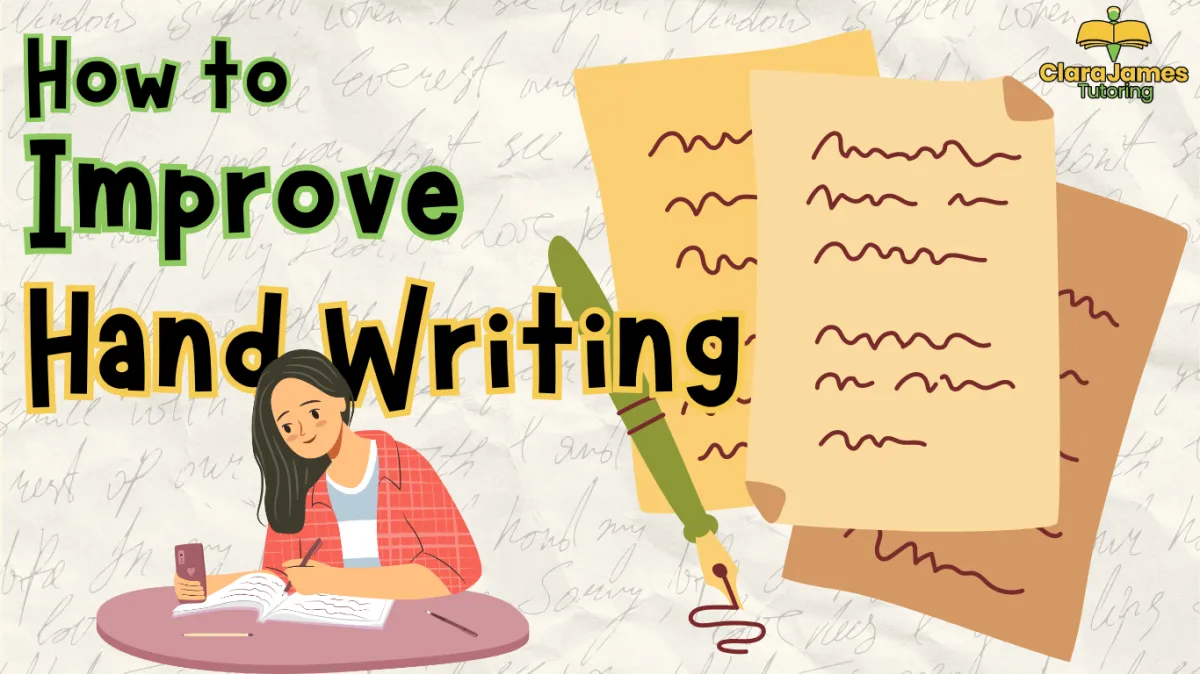Clara James Tutoring
BLOG POSTS

How can I support my child with their hand writing
There are many reasons why people have scruffy handwriting, sometimes it needs to be investigated and like I say, if you are worried about it, it might be worth while trying to get in touch with an occupational therapist.
Something I am often asked about is supporting hand-writing skills.
At a young age this may relate to the hand muscles in the hands not yet being fully developed and I have a few suggestions that may help.

As the child gets older, you may want to find the support of an occupational therapist to provide some suggestions.
1. Start big:
I guess it’s a bit like parking a car. When you are first asked to park a car, you wouldn’t want to park in a narrow gap, you’d hopefully save that until you were more confident, more skilled. Handwriting practice is the same, using a big piece of paper is far better than trying to squeeze your imperfect shapes between two narrow lines. Even better, (if the weather is more forgiving) start by using water to paint on the side of the house, a patio or footpath). Use large movements and as these improve start to shrink it down to what is expected inside a school exercise book.
2. Jenga:
I love this game and we’ve adapted it by writing numbers of the bricks so that we can practice number bonds or the times tables, we’ve also got grammatical terms on others so that we can also practice those. But the skill and care needed to remove the brick from the tower without it all tumbling is a great way to practice the fine motor skills which will in turn support handwriting.
3. Colouring is another suggestion:
keeping the colouring inside the lines is another skill that requires practice and patience. Again, the strokes used in colouring can further aid the shapes created when writing letters.
4. Sewing
again this requires the use of the fine motor skills needed for neat handwriting. You may just do a normal running stitch on a square of fabric, or you may decide to make something or use a more elaborate stitch. Either way I hope this helps.
5. Playdough and clay
are other great early interventions to building up the muscles in the hands. The stronger and more developed the muscles are the more precise we can be with our writing.
To be honest, anything that needs to be precise will help. Many crafts and building activities help.
For some people, messy handwriting is always an issue.
There are a couple of members of my family whose handwriting I always struggle to read, yet they are so intelligent. It doesn't seem to add up. But my daughter says, if she doesn’t write quickly, she can’t remember everything her brain is throwing at her. Her brain works at such a speed.
I used to tutor a girl a couple of years back. I hadn’t realized her mum was an invigilator for the A’ levels at the school my youngest went to.
Not long after Hay sat her history the mum asked me if my daughter was doing her exams now.
Yes.
Does she do History?
Yes. Is she called Angel?
Yes.
She said, I thought it must be your daughter. I have never seen anyone writing so quickly. I expected sparks to come off that page!
There are many reasons why people have scruffy handwriting, sometimes it needs to be investigated and like I say, if you are worried about it, it might be worth while trying to get in touch with an occupational therapist.
Sometimes, practicing using the suggestions above will help. Sometimes, like with Hay, it’s just one of those things that make them, them.
I hope this has helped a bit.
Our goal at Clara James Tutoring is to make learning fun and accessible to everyone. If children are engaged in what they are doing they are more likely to want to participate, if they are enjoying it, they are more likely to relax and retain the information.
If they are retaining the information it will help boost their knowledge and with knowledge comes confidence.
If you have a child who enjoys learning through games and being more creative, and you enjoy spending time with them, you might be interested in the Clara James Approach, the membership group we have put together to support you in supporting your primary school aged child with their maths and English.
Interested?
Click here to learn more: The Clara James Approach
Morning,
I hope the week is going well.
So many people seem to be doing D of E and work experience
at the moment, good luck if that’s you and if you’re at Marlow Camp next
fingers crossed for good weather!
I’ve just finished a lesson on division. It seems to be
something that messes with the brains of so many people.
I found it got easier when I stopped thinking about it as
division and instead thought about it as multiplication. So, if for example I
had the question 396 divided by 3, I would look at it as 3x what = 3. My answer
would be 1. How many times would I need to multiply 3 to get to 9, (my answer
would be 3). Then 3x something = 6. My answer would be 2. Giving me the overall
answer of 132.
I know that’s a really simple example but hopefully it explains
my point.
Thankfully in schools they don’t often seem to need to do
long division, but I’ve worked with a couple of adults (generally nurses for
some reason) who have needed it.
I think I’ll explain this one in a video, as it will be too
complicated to explain it with words as bits get put all over the place. I hope
this makes sense though:
Enjoy the rest of the week and speak soon,
Dawn

